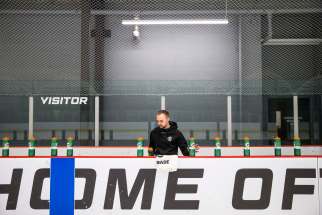Frozen treat City's new Western Hockey League franchise finds early success at box office
Read this article for free:
or
Already have an account? Log in here »
To continue reading, please subscribe:
Monthly Digital Subscription
$0 for the first 4 weeks*
- Enjoy unlimited reading on winnipegfreepress.com
- Read the E-Edition, our digital replica newspaper
- Access News Break, our award-winning app
- Play interactive puzzles
*No charge for 4 weeks then price increases to the regular rate of $19.00 plus GST every four weeks. Offer available to new and qualified returning subscribers only. Cancel any time.
Monthly Digital Subscription
$4.75/week*
- Enjoy unlimited reading on winnipegfreepress.com
- Read the E-Edition, our digital replica newspaper
- Access News Break, our award-winning app
- Play interactive puzzles
*Billed as $19 plus GST every four weeks. Cancel any time.
To continue reading, please subscribe:
Add Free Press access to your Brandon Sun subscription for only an additional
$1 for the first 4 weeks*
*Your next subscription payment will increase by $1.00 and you will be charged $16.99 plus GST for four weeks. After four weeks, your payment will increase to $23.99 plus GST every four weeks.
Read unlimited articles for free today:
or
Already have an account? Log in here »
Hey there, time traveller!
This article was published 21/02/2020 (2121 days ago), so information in it may no longer be current.
It’s a hockey palace, this place.
Less than a year after its official opening, the Rink Training Centre, nestled on a large parcel of frozen prairie between Oak Bluff and what was once the southwestern edge of Winnipeg, still has a new-car smell.
The offices gleam.
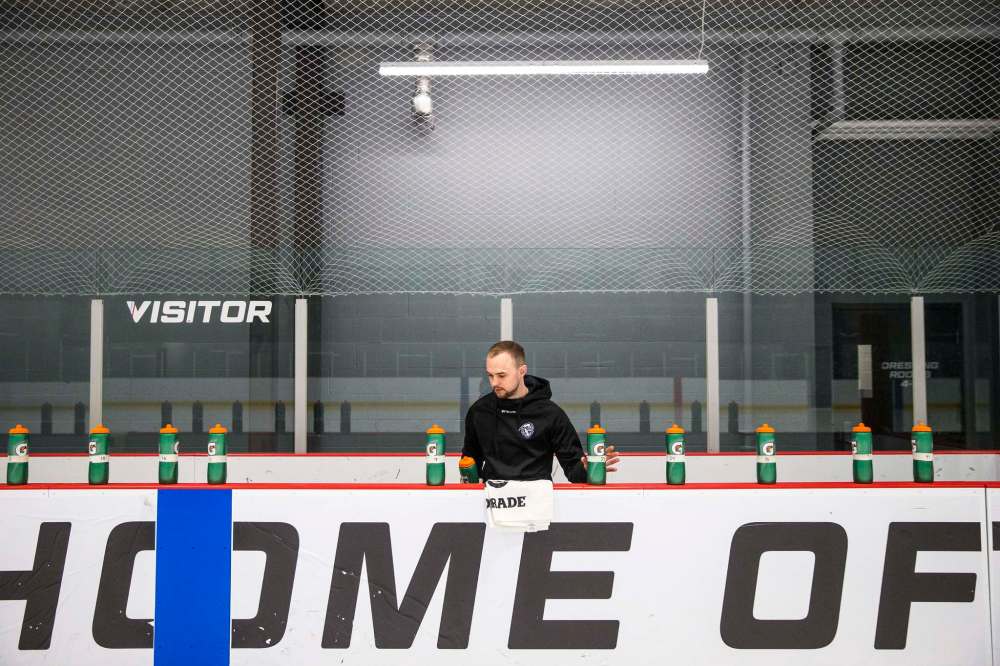
Despite opening last June, the NHL-sized arena surface and the facility’s smaller areas for goalie and player training look brand-new. The players’ study room, coaches’ areas and workout facilities are ultra-modern and immaculate.
And the dressing rooms, well… they’re better than a lot of NHL facilities.
It’s 9:15 a.m. on Feb. 8 — a Saturday game day — and the RTC’s highest-profile tenants, the Western Hockey League’s Winnipeg Ice, are getting back to work.
Yet for all the polish and glitz of major-junior hockey, it is the grinders who will arrive earliest and stay the latest today.
Enter Darris Hardern, the club’s first-year athletic therapist, and Darcy Ewanchuk, the club’s veteran equipment manager.
And though their job titles seem fairly specific, the work requires a willingness-to-do-anything approach. It’s a flurry of activity as they prep for the team’s 10 a.m. skate while also tending to the equipment and medical needs later in the day.
The Ice will face off against the Medicine Hat Tigers in a few hours, and Ewanchuk and Hardern’s predicament is unique.
Home games feel like the team is on the road.
Most of the club’s equipment needs to be packed into a large cargo van for the 11-kilometre trek to Wayne Fleming Arena, the WHL team’s home this season and next while a new arena is built next door to the RTC.
At “the Flem,” the team shares dressing-room facilities with both University of Manitoba hockey teams.
“There’s definitely been a learning curve,” says the 26-year-old Hardern, who was previously employed by the CFL’s Winnipeg Blue Bombers.
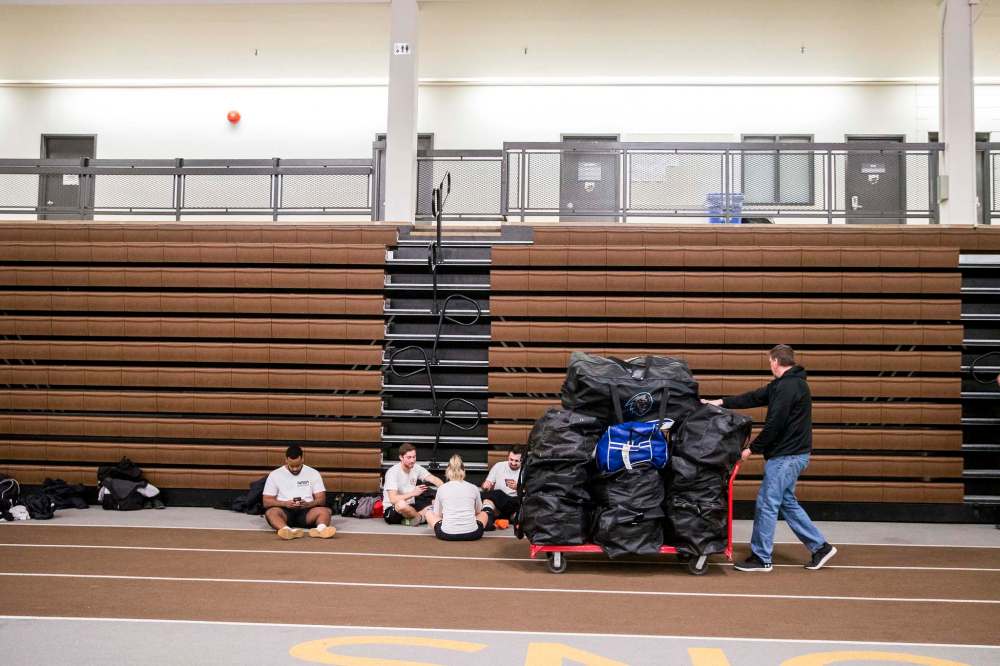
“It’s my first time working with guys that are under the age of 18, so there’s challenges there plus it’s the first time working with this group — coaches, managers, support staff. In this job, there’s always something.”
Caring for the health of the players is Hardern’s priority and sometimes his choices aren’t popular.
“There’s a lot of times where a kid wants to play, which is a good thing,” he says. “It’s easier to bring a kid back on the ice when he’s hungry to get out there, but there’s times they don’t like the decisions that get made by myself or the doctor or the medical team collectively.”
Speaking of collectively, keeping a clean workplace can be a bit of a battle through the season.
The flu is an annual scourge in hockey dressing rooms at all levels and Hardern and Ewanchuk are meticulous about their preparations.
“Now, we try to keep their bottles marked, keep hand sanitizer everywhere,” says Hardern. “If a guy is sick, quarantine him a little bit as early as you can.”
But how do you convince teenagers to use hand sanitizer?
“That’s where you see the difference between a 20-year-old and a 16-year-old,” Hardern says.
The 49-year-old Ewanchuk, originally from Sherwood Park, Alta., is a serious presence around the locker room.
Expert with an industrial sewing machine and skate sharpener, there isn’t a piece of equipment he hasn’t repaired.
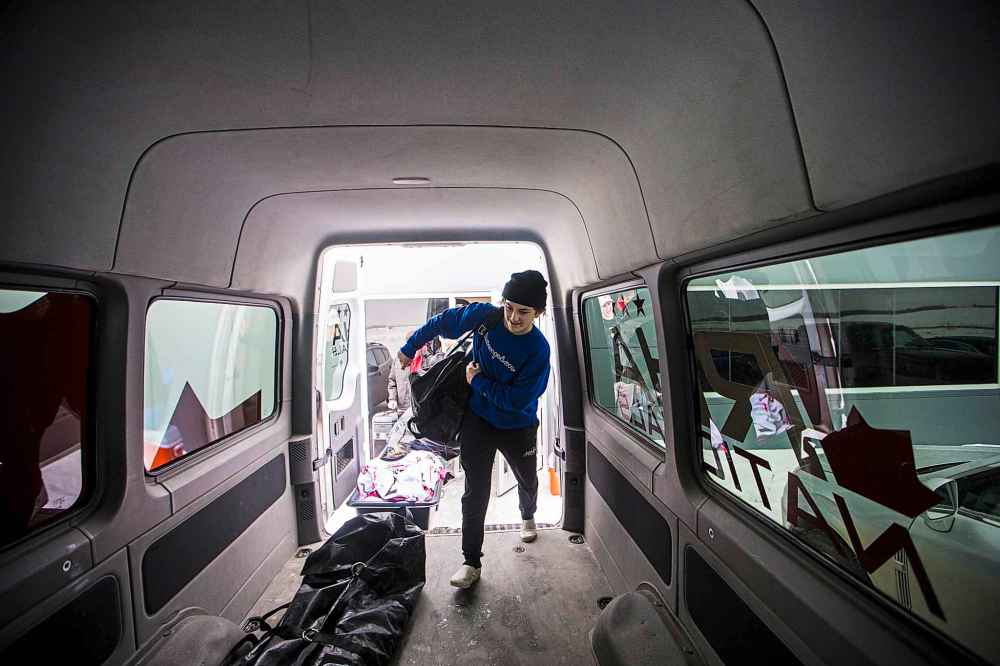
By game day, skate blades have been sharpened (with a backup snap-in set available for each player) but he has to be sure the support staff from the visiting team is supplied with Gatorade, water, shower towels, sweat towels, ice, hot packs, a toaster and coffee machine.
In his 15th season with the franchise, Ewanchuk served during the Ice’s inaugural season in Edmonton back in 1996-97 before rejoining the team in Cranbrook, B.C., from 1999 to 2007. He had stints with the Oil Kings and Tri-Cities Americans before the Ice pulled him back in 2015.
The job, traditionally a dual role melding the duties of equipment manager with the athletic therapist, is fading from junior hockey. Ewanchuk filled both roles in Cranbrook but with increased responsibilities of the modern game, Hardern was added to the mix.
The two are already a well-oiled machine, performing their tasks quickly and with few words exchanged.
“For team pictures and headshots — that’s the only time I smile,” says Ewanchuk, barely able to suppress a grin as they load the van after the morning skate, with players pitching in.
● ● ●
After more than three decades as a player and coach in the NHL, James Patrick has seen a lot.
However, there is one coaching technique, in particular, he prefers to avoid.
“I will never say, ‘Well, when I played,’ because that means nothing,” the 56-year-old Winnipeg native says.
“That was 30 years ago. If there’s a lesson in a one-on-one discussion with a player, I might tell a story about a player I played against. I’ve told the whole team a story about Joe Sakic.”

Patrick’s story involves a chance encounter with the future Hockey Hall of Famer in Calgary during the 1996-97 season.
Patrick, a Flames defenceman at the time, was rehabbing an injury and arrived for a 7 a.m. gym workout. Colorado Avalanche’s Sakic happened by.
“What he did next blew me away,” says Patrick. “This was Friday morning. Thursday night they just beat us, and Saturday night they’re playing in Edmonton and he put on a 40-minute workout of squats, jump squats and (weightlifting) cleans.
“I was really into fitness and I wasn’t doing that. And he had just won the Stanley Cup and was the (playoff) MVP the year before. That’s the captain of Colorado. Why do you think they’re that good?”
While those anecdotes are instructive, it’s crucial for any team to have good on-ice leadership and the Ice believe they have one of the best in star centre Peyton Krebs. Midway through a painful rebuilding season last year, the fiery 17-year-old was appointed captain.
“With the group that we had and where our team was headed, we made the decision last year halfway through, we’re turning this team over to him because of how he carried himself, his work ethic, his drive, his will to get better, the person he is off the ice — all those things,” says Patrick.
“This is who we wanted driving the culture. And Jakin Smallwood, Cole Muir, (Nolan) Orzeck, (Owen) Pederson and (Mike) Milne followed right in line behind him.”
Krebs was away from the team, rehabilitating a partially torn Achilles tendon when the regular season opened, but he quickly reclaimed his leadership role after missing 21 games.
Older players, unfamiliar with Krebs’ leadership style, needed to adjust.
“They had to accept him, they had no choice,” says Patrick. “But I think the positive effect he’s had, even on the older guys — (newcomers) Isaac Johnson and Michal Teply and (trade-deadline acquisition Dawson) Barteaux is exactly the same way. He’s a kid who just wants to get better. He’s respectful and he works.

“All the lessons we want to pass on to young players at 16 — when Connor (McLennon) was 16 he had a long way to go, but all those things, the lessons — what are you thinking about before a game, are you expending your energy and getting ready for a game or helping out with your billets? All those things, Peyton was already doing.”
● ● ●
Barteaux has been with the team for less than a month but has quickly become part of the fabric of the team.
When McClennon, the club’s leading scorer at the time, went down with a regular-season-ending injury in mid-January, the 19-year-old defenceman had an ‘A’ stitched to his jersey.
After today’s morning skate, he continues an already familiar routine. He changes out of his gear and heads five minutes east on McGillivray Boulevard with a handful of teammates for his standard 11:15 a.m. breakfast of Eggs Benedict at the Original Pancake House.
Before leaving for the rink this morning, he got a quick energy boost from a smoothie consisting of spinach, strawberries, a little bit of yogurt, a scoop of protein powder and milk.
“I am a guy who enjoys my routine and like doing it every day,” says Barteaux. “I’m also a big stretcher before the game. I like certain stretches that I do as soon as we’ve done our team warmup. I have some that I do on the floor and some active stretches. That’s just built up over the years.”
After breakfast, he heads home to relax while catching up with his billets or watching something on Netflix. A pregame nap is next —never longer than 80 minutes — followed by a meal (chicken and rice or pasta; “the sauces and spices on the chicken are switched” for variety) and a shower.
Next, he puts on a suit and drives to Wayne Fleming Arena, stopping for a medium double-double at Tim Hortons before a 5:30 arrival at the rink.
The game is two hours away.
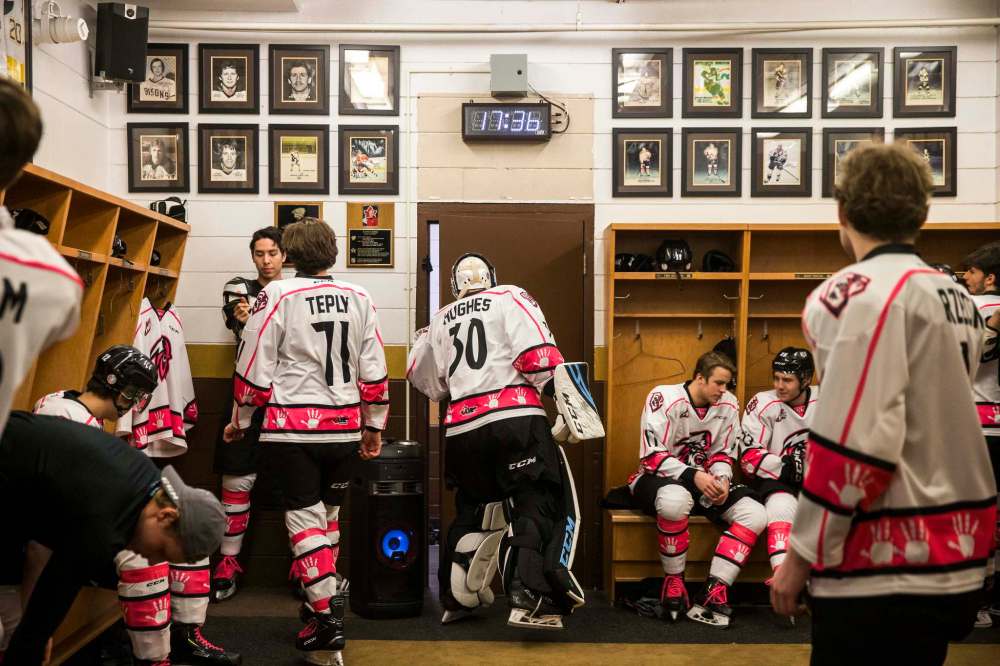
● ● ●
Mack Heisinger’s job title — he’s the team’s manager of business and digital operations — suggests his job casts a wide net. And it does.
Need an interview? Text Mack. Printing up game notes and programs? That’s part of his gig, too. Who runs the in-game audio and video presentation during the game? You’re looking at him.
Game day is a marathon for the 25-year-old, one of four hockey-playing sons of Winnipeg Jets assistant GM Craig Heisinger. He’s at the RTC at 9:30 a.m. and won’t leave Wayne Fleming Arena until 11 or 11:30 p.m.
On May 21, he loaded up his 2006 Hyundai Santa Fe, which has more than 350,000 kilometres on the odometer, and drove home from Curry College in Milton, Mass., to start his new job five days later.
He says multi-tasking is part of his makeup.
“I really enjoy it now,” says Heisinger, a communications and business grad at Curry, where he also captained the hockey team. “Everywhere I played I was kind of put in that role. Now it’s believe in yourself. You’ve got to believe in what you’re doing and other people will believe that, as well.”
Soon after puck-drop, the Tigers are pressing, outshooting the Ice 16-7 in the opening period but Ice goaltender Liam Hughes is equal to the task and the hosts strike first on offence when over-age defenceman Reece Harsch takes a cross-ice feed from Teply and snaps a long shot past Medicine Hat goaltender Garin Bjorklund.
All the while, Heisinger is wearing a headset and keeping an eye on the action while he supervises off-ice officials, video-production staff and in-game host A.J. Leite, while also queuing up between-whistle promos and scoreboard graphics. He appears to be permanently attached to an iPad, which puts him in control of everything.
“My job comes down to a lot of whistles,” says Heisinger. “In game, when we have stuff to fit in during whistles there’s points in play where you’re going five, six, seven minutes without a whistle and you’ve got a lot to fit in. It’s tough, because you don’t want to take away from the flow of the game and have the PA or the host going every whistle.”
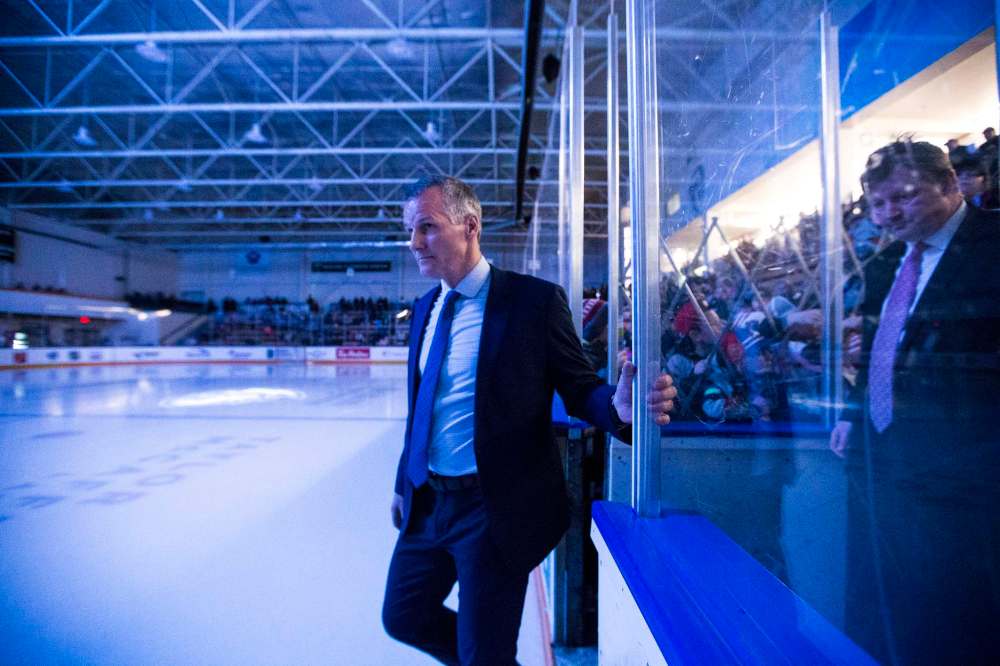
After the final buzzer, photos must be sent to the visiting team, league office, posted on the Ice website and social media. It’s a similar format for the post-game report; graphics, interview videos with players and coaches and highlights need to be uploaded to the team website and social media.
“And then we tear everything down,” he says.
● ● ●
Junior hockey has many characters, some with a tougher edge than others; Ice play-by-play man Mitch Peacock isn’t one of them.
A broadcasting pro with more than two decades of experience in television and radio, the 52-year-old Castlegar, B.C., native is as down to earth as they come.
He’s enjoying the major-junior product more than ever.
“The game has changed,” says Peacock, who called games for the WHL’s Prince Albert Raiders between 1998 and 2000. “I think there’s such an emphasis on skating and skill and I think we’ve seen in hockey a lot of the fighting and rough stuff is out, which is only for the good, in my opinion.
“It’s a really good brand of hockey to watch. The skill is there and the speed is there. You see great plays every night.”
Peacock believes unpredictability is one of the things that makes WHL action so compelling, and tonight is a case in point. The Tigers, a Central Division powerhouse, have been holding their own in the second period when Teply, using a lightning quick release he honed in his native Czech Republic, one-times a rebound past Bjorklund after linemate Kreb’s original shot at 16:38.
The two-goal lead doesn’t last long — Medicine Hat sniper James Hamblin finally solves Hughes with 15 seconds remaining in the period. Winnipeg leads 2-1 after 40 minutes.
“One of the things people like about junior hockey is that because they’re young and inexperienced, you see mistakes and mistakes lead to chances and goals,” Peacock says. “We’ve seen some games where teams have been up three or four (goals) and all of a sudden it’s a tie game.”
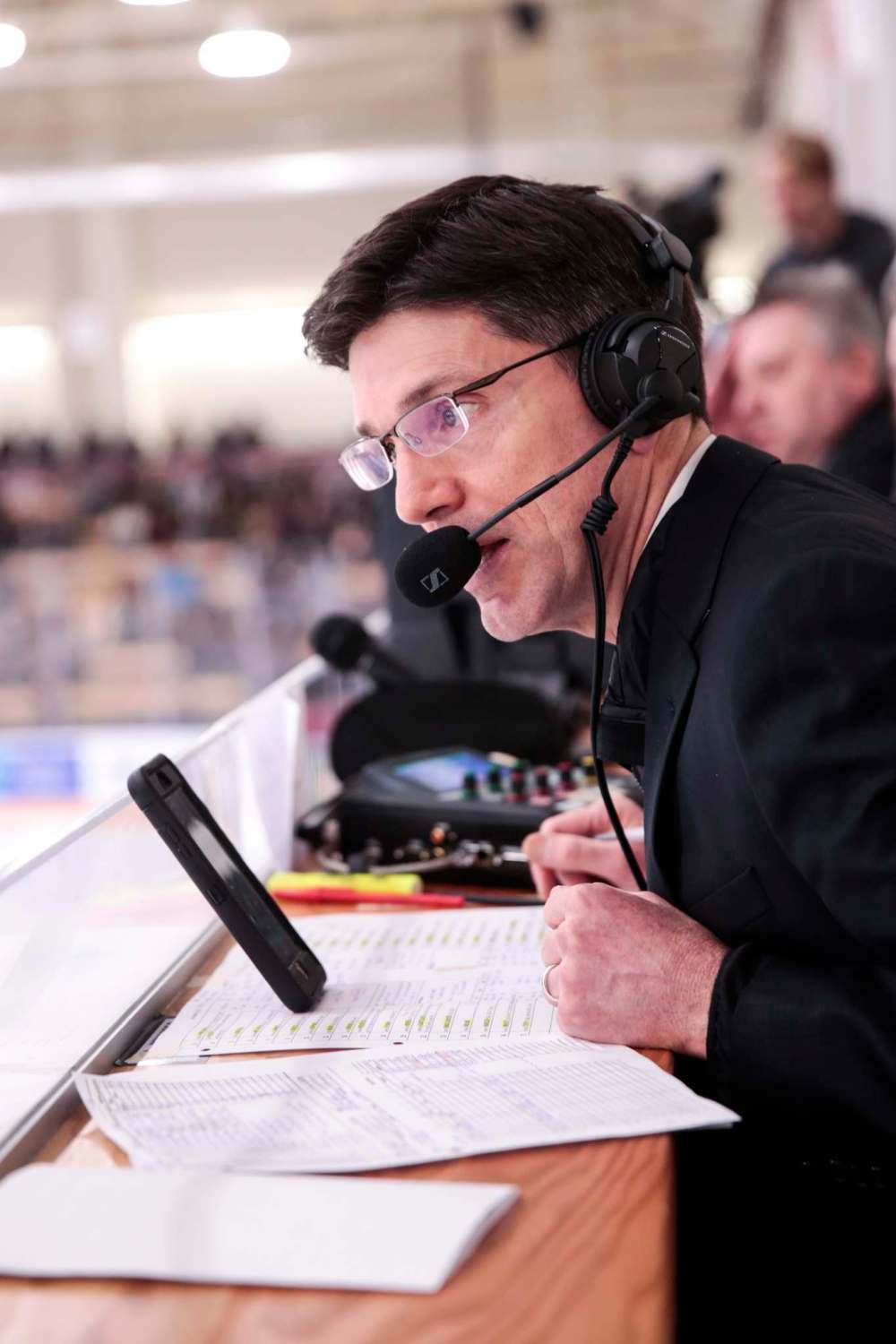
There are other potential thrills and spills at an Ice game, particularly from his press-box perch barely just four metres above ice level.
Wayward clearing attempts can fly into his unprotected workspace. Have there been any direct hits yet?
“Knock on wood, not so far,” says Peacock, tapping his head. “But you’re not going to beat this for a vantage point, I’ll tell you that. It reminds you of the speed of it. Sometimes when you’re watching on television or if you’re in a big facility, it’s easy to get detached and not appreciate how quickly things are moving.”
● ● ●
It’s the show within the show.
A.J. Leite, the Ice game-day host, is on the move before puck-drop. Tonight, he’ll be doing on-camera giveaways or promoting the club’s Pink the Rink anti-bullying campaign and Teacher Appreciation night. The team is wearing commemorative jerseys to highlight the biggest public service initiatives of the season.
Leite’s focus is to encourage fun in the stands.
He says most fans were reluctant to engage at first, but Winnipeggers have begun to embrace a more care-free approach.
Recently, two young fans showed up in shorts, mimicking Leite’s aversion to pants.
“I don’t do pants in the wintertime,” says the 36-year-old radio veteran, formerly Gonzo on Power 97, but now working middays at Energy 106. “I never enjoy them — unless I’m outside for an extended period of time.”
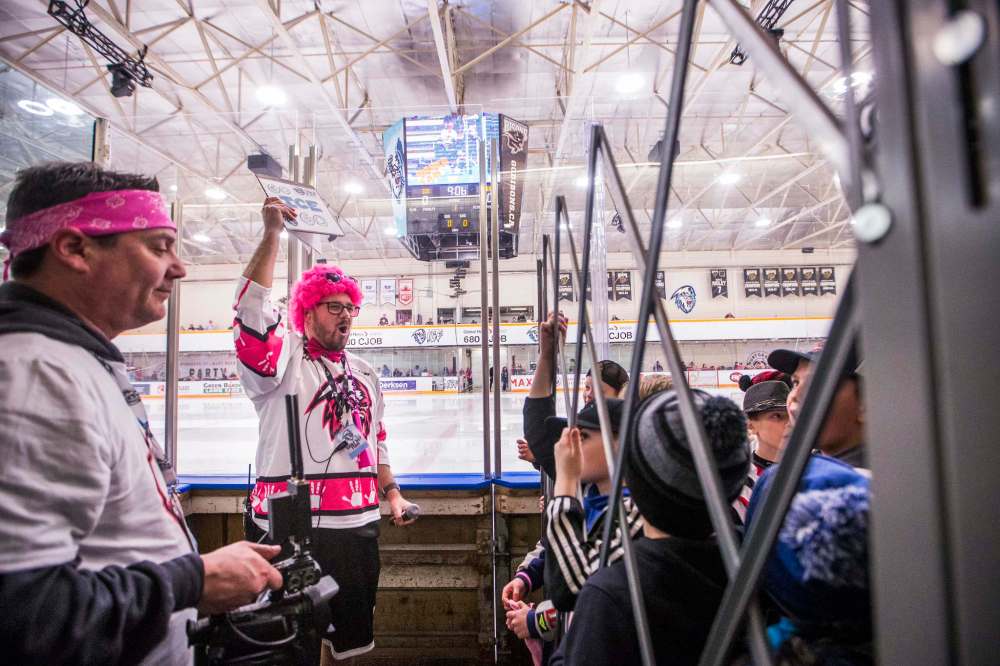
Fans no longer scurry for cover when Leite sits down in their section.
“I don’t think we’ve taken a different approach to it,” he says. “People are more open to it now. The start of the new season was the start of a new team, and so people are coming in here not knowing what to expect but now I think they’re getting it. We’re in the stands, we’re talking to people when they come in the front door and I think they appreciate it.”
Meanwhile, the lure of a new venture brought Erin Petreny to the Ice in summer.
She’s the volunteer co-ordinator of volunteers, a crew of 30 or so folks who look after ushering, promos, handouts, supervising minor hockey teams during intermissions and the sale of 50/50 tickets.
“I’m only 21 but I’ve worked in sports my whole career and I just love bringing a fun atmosphere to people, seeing the look on their faces when we do a promo or when we score,” says Petreny. “I love sports and I love bringing that joy and they’ll be back because of it.”
Seeing repeat customers coming through the door is very gratifying, and putting a good product on the ice hasn’t hurt.
“The people that come in are telling their friends and family, ‘Oh, we had this great time, we got a hockey stick that was tossed over the side,’ and then they got it signed in Autograph Alley after the game by that same player,” she adds. “So they’re getting these experiences, telling the friends and family and the word’s getting out.”
Back on the ice, Winnipeg kills off an early Medicine Hat power play in the third and midway through the frame, the hosts take a 3-1 lead when Smallwood crashes the net to cash in on a setup from Jackson Leppard.
● ● ●
Derek Williamson is old enough to remember his dad taking him to see the Winnipeg Warriors, who left town for Moose Jaw, Sask., in 1983-84 after four money-losing seasons in the WHL.

Now 44, Williamson insists being an Ice season-ticket holder makes for a great place to bring his wife Andrea Duke and their kids, seven-year-old Brayden and Avery, 5.
“It’s actually exceeded my expectations, honestly,” he says. “I wasn’t too sure what we were getting when they came here and the (second) weekend didn’t go so well (Winnipeg was outscored 11-0 in two home losses). But they’ve really turned it around and they’ve got a really good team.”
Do his kids really enjoy the hockey?
“Big-time,” he says as Brayden gets autographs between periods from rookie forward Matt Savoie, a healthy scratch, and injured veteran forward Isaac Johnson.
“And that’s another reason to become a season-ticket holder — (it) was for him. At the start of the year, he wasn’t really into it. Now, he’s high-fiving, getting autographs and asking the guys for sticks.”
Andrea, 44, has also found a comfort zone at Ice games.
“I just come for the fun,” she says. “I just like watching the guys play and watching my family be involved. It’s comfortable here. Nice environment. Everybody’s friendly and I can watch (the kids) and know where they are and still watch the game.”
Those reviews are music to the ears of Leah Watkins, the club’s director of business operations and one of the current employees who made the move from Cranbrook.
The fan demographic, Watkins has found, is much younger in Winnipeg.
Game-day reserved seating is $27 for adults, $22 for youth and $15 for students, not including fees, and standing-room options are $20 for adults and $15 for youth.

“I’ve definitely learned we’re a family dynamic, which is great because a lot of our activations, our in-game activities are focused on families,” says Watkins.
“We’re a different option, we’re an affordable option. It’s easy for families to get tickets. I think it’s less than going to the movies, which is pretty crazy.”
Understanding their clientele better is about to spark a change at Ice games that is being experienced in other spectator sports. Namely, younger fans seem less interested in having a designated seat to watch a game. Ice regulars can expect fewer structured seating areas in 2020-21 and beyond.
Movement will be encouraged.
“Sit at ice level, sit at the top, sit in the middle.” says Watkins.
I think it’s going to be pretty popular.”
● ● ●
Travis de Koning admits he had limited knowledge of the WHL prior to the season. The talk of the team relocating to Winnipeg was mostly out of mind.
But then, a casual summertime conversation with a friend who was planning to sign up to billet an Ice player prompted de Koning to consider the idea.
“I came home and I mentioned it to my wife — we have two boys — and she said, ‘That’s a fantastic idea, why don’t we do it?’” says the 38-year-old de Koning, who has his nine-year-old Ashton with him tonight.
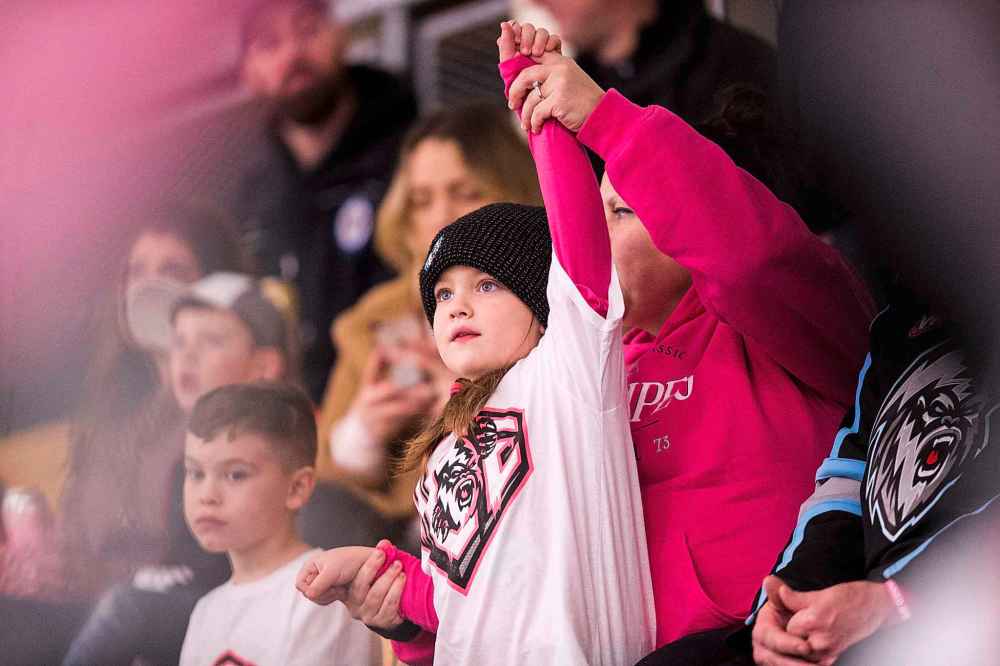
“The whole logic was these kids are really unbelievable. They work hard, they’re dedicated, they’re really focused on what they do and for us, it was about setting really good examples for our two boys.”
Ashton and his brother Dane, 6, have become regulars at games. Their interest is laser-focused on Krebs, who also happens to live at the de Koning home.
With less than three minutes remaining, Krebs sets up Teply for an empty-net goal. The Ice will win the 4-1, keeping pace with Prince Albert for top spot in the East Division.
“Every once in a while he’ll skate by and wave,” says de Koning. “The kids really seem to like that.”
The de Konings have witnessed Krebs’ maturity and dedication to his craft. The surprise, perhaps, is how quickly the first-round draft pick of the Vegas Golden Knights integrated with his Winnipeg family.
“I think all these kids are pretty good but Peyton’s pretty unique,” says de Koning. “He’s done very well because he wants to be part of the family. He’s not the kind of person who wants to sit in the basement playing video games. What’s neat about him is he makes sure that he’s home and he waits for (Ashton and Dane) to get home from school and then it’s playtime.”
● ● ●
The fast pace of the game, which ended at 10:02 p.m., is countered by the slow-motion of the post-game. Members of the coaching staff huddle to digest what they’ve just seen and the players emerge from the dressing room slowly.
Ewanchuk and Hardern are moving more quickly, with more than an hour of work remaining before they can call it a night.
McClennon, the club’s injured star, is hovering at the dressing-room entrance with his shoulder and arm in a sling. He greets old friends from the Medicine Hat side.
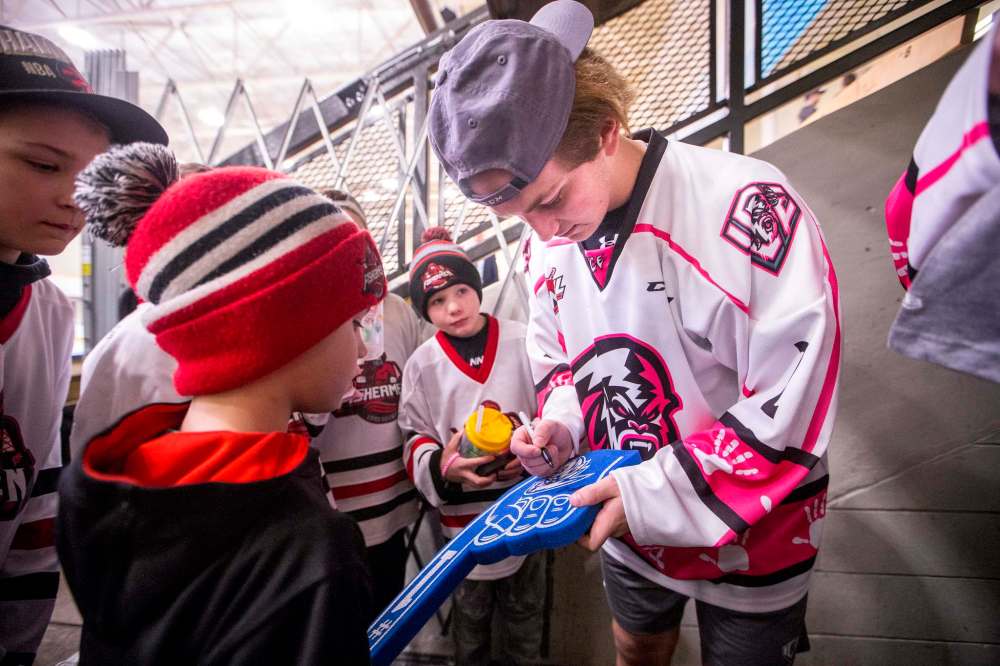
Hughes emerges 15 minutes later, sweat still dripping after his 39-save performance.
The 20-year-old has been stellar since joining the club in early December, winning 15 of his first 21 starts while posting save-percentage and goals-against numbers that are among the league leaders.
Could he have believed he would be this successful?
“No, honestly,” says Hughes, who quit the game in January 2019 before being lured out of retirement after a nine-month absence. “If you would have said two months in how well we would have been doing and I’d have 15 wins, I would’ve been ecstatic. I don’t think I would’ve believed it.
“But here we are.”
mike.sawatzky@freepress.mb.ca
Twitter: @sawa14

Mike Sawatzky
Reporter
Mike has been working on the Free Press sports desk since 2003.

Our newsroom depends on a growing audience of readers to power our journalism. If you are not a paid reader, please consider becoming a subscriber.
Our newsroom depends on its audience of readers to power our journalism. Thank you for your support.



